If Not This, Then What?
An Inquiry into Cultural IdentityMFA Thesis Proposal
OCAD U
GGRA - Thinking Through Making, Professor Michelle Gay
2022 May - 2022 August
In my MFA thesis, I explore the intra-actions within Azerbaijan’s entangled cultural identity in its continuous state of becoming, combined with a feminist reading of Soviet Azerbaijani cinema, by projecting fragments of Soviet Azerbaijani films in an installation. These elements are explored through a practice involving refractive materials, such as metals, plastics and fabrics with video mapping and visual projections to play with visual images, archival film as dialogue, visual and cultural representation, and haptic renderings. In essence, I am continuously searching for Azerbaijan’s “cultural identity” through fragmenting, reconstructing, veiling, revealing, layering – without intending to symbolize or concretely determine its parameters.
I intend this project as an initial prototype for experimentation, play, thinking and as a ground for curiosity for my final thesis installation.
I would like to acknowledge my deep gratitude to Julian Haladyn, Veronika Szkudlarek, Simone Jones, Gerald Grison, Toğrul Abbasov, Aygün Aslanlı, Lalə Əliyeva, Rəhman Badalov and my mother for our insightful conversations to support the conceptualization of this installation.
Keywords: cultural identity, Soviet Azerbaijan, cinema, haptic reading
OCAD U
GGRA - Thinking Through Making, Professor Michelle Gay
2022 May - 2022 August
In my MFA thesis, I explore the intra-actions within Azerbaijan’s entangled cultural identity in its continuous state of becoming, combined with a feminist reading of Soviet Azerbaijani cinema, by projecting fragments of Soviet Azerbaijani films in an installation. These elements are explored through a practice involving refractive materials, such as metals, plastics and fabrics with video mapping and visual projections to play with visual images, archival film as dialogue, visual and cultural representation, and haptic renderings. In essence, I am continuously searching for Azerbaijan’s “cultural identity” through fragmenting, reconstructing, veiling, revealing, layering – without intending to symbolize or concretely determine its parameters.
I intend this project as an initial prototype for experimentation, play, thinking and as a ground for curiosity for my final thesis installation.
I would like to acknowledge my deep gratitude to Julian Haladyn, Veronika Szkudlarek, Simone Jones, Gerald Grison, Toğrul Abbasov, Aygün Aslanlı, Lalə Əliyeva, Rəhman Badalov and my mother for our insightful conversations to support the conceptualization of this installation.
Keywords: cultural identity, Soviet Azerbaijan, cinema, haptic reading
Context
“Azerbaijani” as a distinct identity is relatively new, primarily informed starting from the 19th century. Before the modern era, the nomads of the South Caucasus region were referred to as “Tatars”, “Turks”, or simply “Muslims”. However, none of these descriptions were comprehensive to their history. Starting from the modern era, Azerbaijan instead became a reaction to the economic prosperity resulting from the oil boom of the 19th century, which brought modernization projects including institutions by the local intelligentsia, women’s education and advancement of rights, new European-inspired architecture expanding around Baku’s icherisheher (old city), and the geopolitical consequences of the 1917 Russian revolution. As Azerbaijan joined the USSR in 1922, the existing “Muslim” and “Turkic” identities were enclosed under a homogeneous Sovietized identity. The process of Sovietization did include “mindcolonization,” “self-orientalization,” “self-racialization,” which resulted in the development of societal and cultural inferiority complexes[1] of the Sovietized states. This created dissonance between ‘tradition’ (alternatively, xalq mentaliteti or public mentality) and the uncertainty brought by ‘modernization’ (considered as “western” or “Russian” influences). As Sovietization allowed for a stereotypical, caricaturized ideal of cultural representation, an interplay formed between a ‘supposed’ identity that exists within the protective barriers of xalq mentaliteti against the suspicion of “western” modernizing forces, which had already permeated through society. This implies that the dynamic between “tradition” and “Sovietization” are not binary forces but faces of identity that perpetually reflect and generate within the existing cultural mesh.
The current understanding of Azerbaijani identity focuses on the ongoing effects of the Nagorno-Karabakh wars of 1987 and 2020, the commodification of traditional culture for tourism, and the subsequent nationalism and authoritarianism driven by the current governance. I am particularly interested in analysing Azerbaijan during the timeframe between 1920s to 1980s, as the newly forming Azerbaijani identity can reveal what is ignored going forward in recognizing the dynamicness Azerbaijani’s cultural identity.
“Azerbaijani” as a distinct identity is relatively new, primarily informed starting from the 19th century. Before the modern era, the nomads of the South Caucasus region were referred to as “Tatars”, “Turks”, or simply “Muslims”. However, none of these descriptions were comprehensive to their history. Starting from the modern era, Azerbaijan instead became a reaction to the economic prosperity resulting from the oil boom of the 19th century, which brought modernization projects including institutions by the local intelligentsia, women’s education and advancement of rights, new European-inspired architecture expanding around Baku’s icherisheher (old city), and the geopolitical consequences of the 1917 Russian revolution. As Azerbaijan joined the USSR in 1922, the existing “Muslim” and “Turkic” identities were enclosed under a homogeneous Sovietized identity. The process of Sovietization did include “mindcolonization,” “self-orientalization,” “self-racialization,” which resulted in the development of societal and cultural inferiority complexes[1] of the Sovietized states. This created dissonance between ‘tradition’ (alternatively, xalq mentaliteti or public mentality) and the uncertainty brought by ‘modernization’ (considered as “western” or “Russian” influences). As Sovietization allowed for a stereotypical, caricaturized ideal of cultural representation, an interplay formed between a ‘supposed’ identity that exists within the protective barriers of xalq mentaliteti against the suspicion of “western” modernizing forces, which had already permeated through society. This implies that the dynamic between “tradition” and “Sovietization” are not binary forces but faces of identity that perpetually reflect and generate within the existing cultural mesh.
The current understanding of Azerbaijani identity focuses on the ongoing effects of the Nagorno-Karabakh wars of 1987 and 2020, the commodification of traditional culture for tourism, and the subsequent nationalism and authoritarianism driven by the current governance. I am particularly interested in analysing Azerbaijan during the timeframe between 1920s to 1980s, as the newly forming Azerbaijani identity can reveal what is ignored going forward in recognizing the dynamicness Azerbaijani’s cultural identity.
I will approach my subject through Soviet Azerbaijani cinema as a starting point for my inquiry into Azerbaijani cultural history between the 1920s and the 1980s. Soviet-Azerbaijani film acted as an accessible medium for the didactic imposition of Soviet idealism onto the Azerbaijani public. Even through the intrusion of Soviet idealism and the subsequent artistic constraints, the domestic and social narrative of Soviet-Azerbaijani cinema bore a textural weaving of Azerbaijani cultural identity.
Soviet Azerbaijani films are still prevalent in current societal discourse and provide a recognizable visual materiality for my inquiry. Visual materiality entails any audio-visual scenes (domestic documentation, public spectacles, urban panoramas, material shots, etc.) where I can search for fragments of Azerbaijani cultural identity. In this query, I am curious about the intersection of social representation involved in the production of the films in response to the socio-political context, while using archived cinema segments projected on refractive materials in my installation. In viewing cinematic footages, I will predominantly derive my understanding from Giuliano Bruno’s conceptions of “haptic connections,”[2] which describe how the observer is ‘placed’ through the eye (and “I”, as the observer), and Laura Mark’s considerations of “tactile memory,”[3] which argues that private memories are embodied in cinematic knowledge. This form of haptic understanding allows me to additionally comprehend the films otherwise, in a non-structural and traditional understanding of film reading. Through piecing, reconstructing, and fragmenting visual materials onto physical formations, I am able to form a relationship between the complex intra-actions in an installation.
It’s important to note when considering Azerbaijani identity that this research focuses on the capital city of Baku, which during the 1920s to 1980s was home to peoples of many origins, such as Armenian, Georgian, Russian, among other communities living among the majority Azerbaijani population. The majority of Soviet-Azerbaijani films take place within and around Baku, especially returning to içərişəhər. To contain my research, I will not be considering the cities and villages outside of Baku in Azerbaijan.
[1] Madina Tlostanova, “Postsocialist ≠ postcolonial? On post-Soviet imaginary and global coloniality,” Journal of Postcolonial Writing 48, No. 2 (London: Mortimet House, 2012): 132.
[2] Giuliana Bruno, Atlas of Emotion: Journeys in Art, Architecture, and Film (London and Brooklyn: Verso, 2018), 348.
[3] Laura Marks, The Skin of the Film, (Durham and London: Duke University Press: 2000), page 127.
Project research questions:
What does the categorization of Soviet Azerbaijani films reveal in the underlying narrative of the sociopolitical context?
How is “culture” or “self-actualization” represented within the censored framework of Soviet imposition in Soviet Azerbaijan cinema? How can tradition, nationalism, religion and sovietization be understood in relation?
What am I truly looking for when I mention “cultural identity”? What are my efforts to avoid “national identity”? How do they differ? what would remain if they’re extracted?
 Images above show the installation’s inital conception. All objects were gathered from the scrap bins of the fabrication studios at OCAD U. The materials include metals, acrylic sheets, and fabrics. The set up of the objects were delicately balanced on each other. I intended to find materials as an introduction to the eventual materials I wanted to explore for the final project. However, I enjoyed the process of searching for materials itself, creating an assimilitude with ‘found’ footage and ‘found’ materials, being curious of their inherent qualities and the outcomes of pairing these findings together.
Images above show the installation’s inital conception. All objects were gathered from the scrap bins of the fabrication studios at OCAD U. The materials include metals, acrylic sheets, and fabrics. The set up of the objects were delicately balanced on each other. I intended to find materials as an introduction to the eventual materials I wanted to explore for the final project. However, I enjoyed the process of searching for materials itself, creating an assimilitude with ‘found’ footage and ‘found’ materials, being curious of their inherent qualities and the outcomes of pairing these findings together. The scenes used in this iteration is from the film “A Day Passed” (Gün keçdi, director Arif Babayev, 1971). The scenes, in order:
The scenes used in this iteration is from the film “A Day Passed” (Gün keçdi, director Arif Babayev, 1971). The scenes, in order:Flowing with Bakının küləyi (Baku’s wind) on top of a house in İçərişəhər; a woman (the main character, Əsmər) removing the white bedsheets; an old man’s hand brushing over the walls of İçərişəhər; the textured stones of the same walls; destruction of İçərişəhər houses; a modern officebuilding; a woman (Əsmər) dancing in twirls; a crowd of men, family members and musicians gathered at the courtyard celebrating a wedding; a discontented old woman nagging; a final scene panning across the famous lookout of Baku ending at the visual of the Caspian sea. Each scene contains camera movements panning, zooming in/out, following action – drawing a vista of textures, familiar and nostalgic moving-images of living in Baku.
The fragments of the film (used in a previous studio work, experimenting with sculpture) interpolated onto the scultpural form inquires into the process of cultural identity formation. To metaphorize self-representation further, the projector’s gaze falls onto the sculpture, alluding to the scrutiny of xalq mentaliteti that self-ethnisizes and flattens a complex understanding of the becoming of cultural identity. As the projection’s light illuminate the fixed sculptural form with moving imagery, the visuals of the surface and surrounding sillhoutte become fluid. The fluidity of visual images in a non-linear narrative hinder a static reading of the sculptural form, creating a passing understanding. Identity becomes a normative ideal,[4] one that a form forms into rather than forms ‘with’ and ‘out of’. As the installation is created through visual parts in exchange with the sculpture, the interchange of visual differences and textures create a whole that evoke sensing and memories that belong to a familiar “unknown body.”[5] This interchange reflects the coexistence of nostalgical ‘tradition’ (as the past narrative contained through the present) faced with ‘progress’ (which does not recognize its past identity)[6] with each other. Similarly, an interchange forms between ‘public’ and ‘private’ social performance, and ‘absence’ and ‘presence’ with what is mapped/lost in the visual imagery. The dynamic relationship formed between a static and fleeting understanding of visual rendering reflects the understanding of cultural identity formation. For the new iteration of the installation, I wanted to explore with new film materials.
[4] Judith Butler, Gender Trouble (New York and London: Routledge, 2007), 23.
[5] Laura Marks, The Skin of the Film (Durham and London: Duke University Press, 2000), 148.
[6] Svetlana Boym, The Future of Nostalgia (New York, Basic Books, 2001), 76.
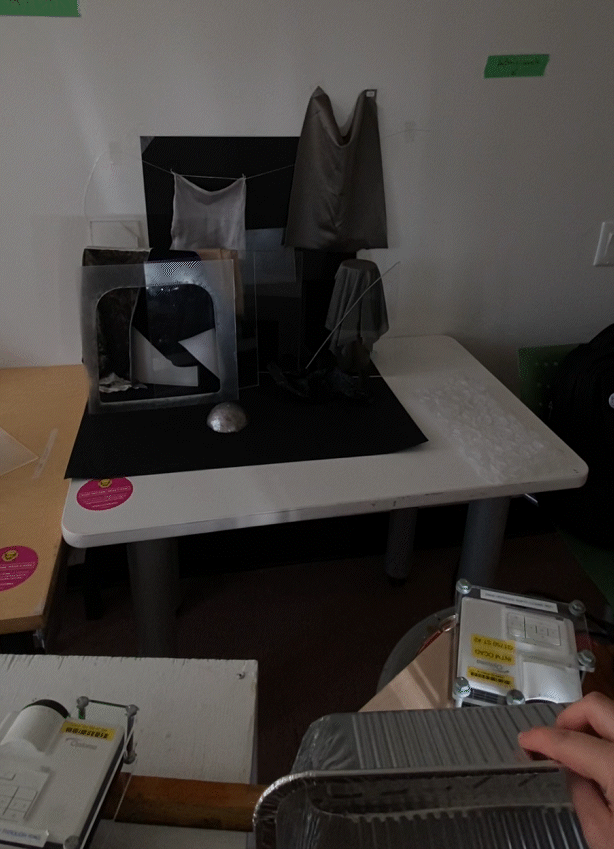

The experiments following the initial conceptualisation was to explore the ways the refractive materials interacted with each other when projected with images, both colored and black and white.

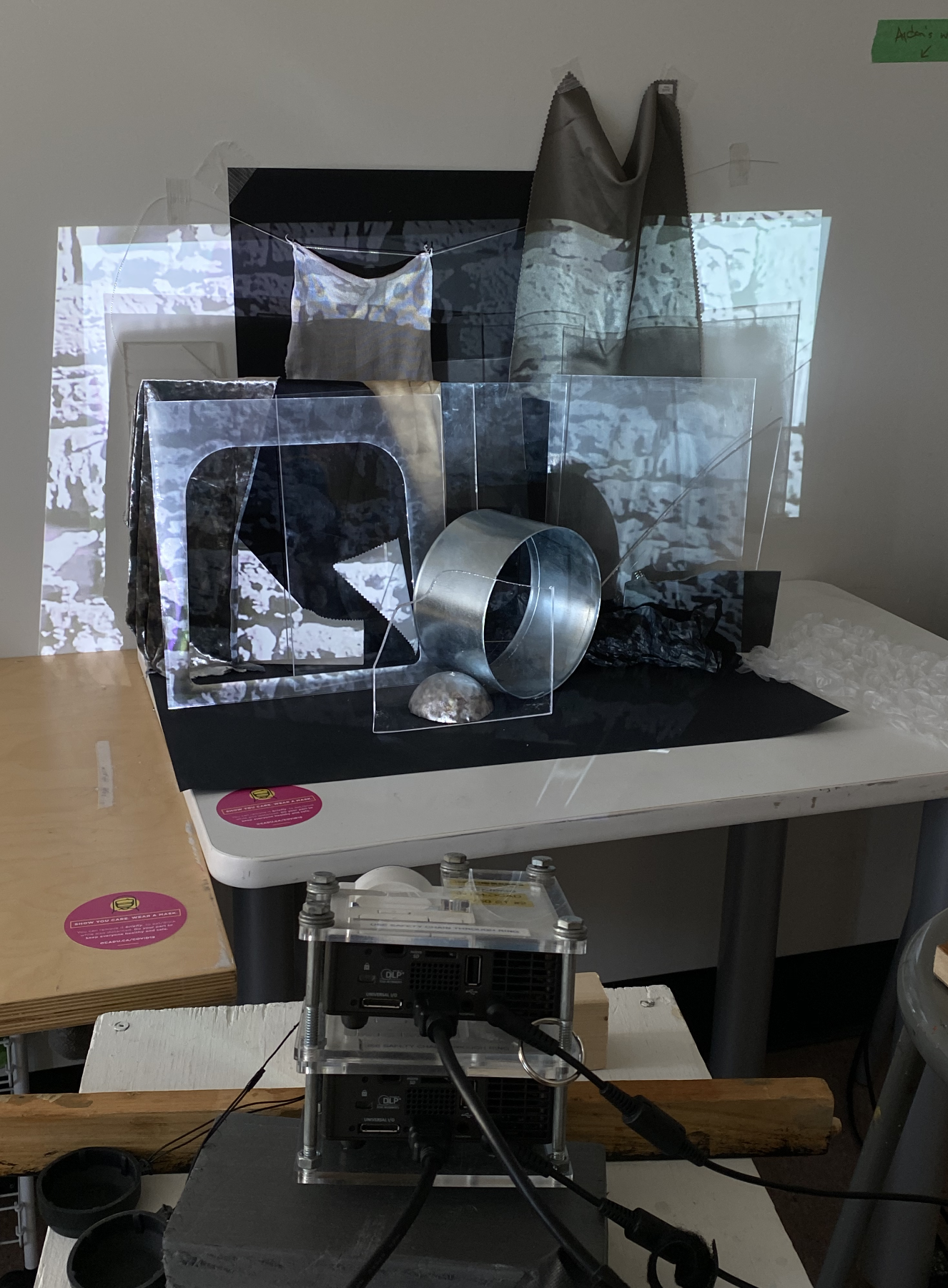
In one iteration I wanted to simultanously incorporate multiple projections. However, this showed to be visually overstimulating that did not serve the vision for the project.
I additionally tried hammering, scratching, sanding, bending some of the materials to embody my own narrative into the memory of the found materials. The more I altered the material, the more would the projections morph on the surface of reflections.
Sanding the acrylic provided a dual surface, with the sanded surface holding the reflection, while the unaltered side would bounce the reflective light of the projection.
Sanding the acrylic provided a dual surface, with the sanded surface holding the reflection, while the unaltered side would bounce the reflective light of the projection.
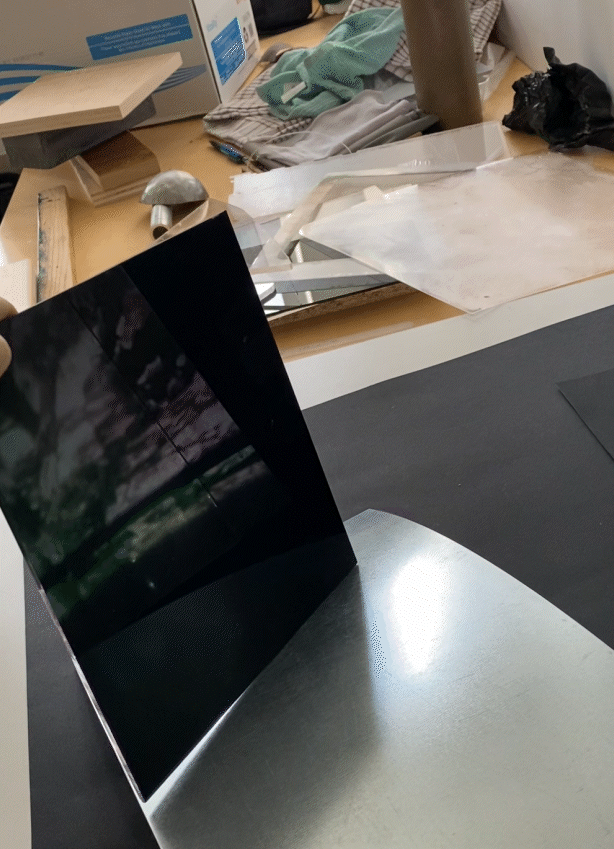
I found that dark plastics could refract the entire setup while also holding the video projections, while lighter acrylic materials could only show the passing of the images.

I experimented with grey fabrics that alluded to the metals present in the installation. Even though the visual quality would seem similar in the dark setting of the installation, they would render different level of legibility and refraction.

I was curious to layer these different materials, noticing how the legibility of the image would change with each added material, specifically with plastics and low-density fabrics that can pass through the projected image onto the next surface.
 Part of my visual explorations were to avoid, as I would like to call, “the pomegranate problem”: placing any item or cultural element that is stereotypically self-advertised as the token of cultural denominator. This includes “buta”, pomegranates, carpets, tea, amongst other elements. These symbols oversimplify identity into static digestible forms that can easily be commodified for tourism. These symbols then become internalized within the culture itself, inhibiting a dynamic understanding of culture by the local community.
Part of my visual explorations were to avoid, as I would like to call, “the pomegranate problem”: placing any item or cultural element that is stereotypically self-advertised as the token of cultural denominator. This includes “buta”, pomegranates, carpets, tea, amongst other elements. These symbols oversimplify identity into static digestible forms that can easily be commodified for tourism. These symbols then become internalized within the culture itself, inhibiting a dynamic understanding of culture by the local community.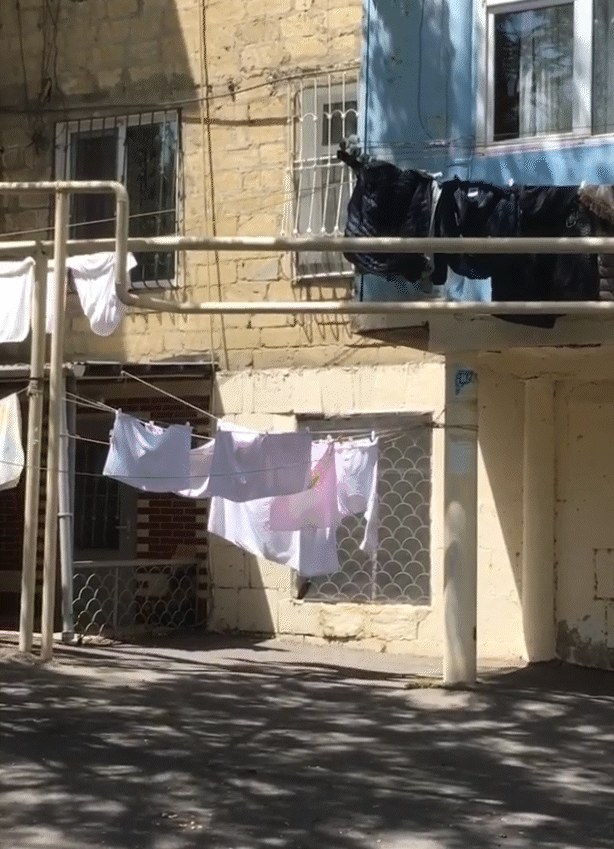 In this regard, I was curious to search for identity in existing fragments within Baku. I thought of Baku’s ever present wind, and how in domestic spaces, cloths are hung in courtyards of apartment complexes. Although not specific to Azerbaijan, these fragments carry the sensibility and texture of cultural identity that I was soughting out.
In this regard, I was curious to search for identity in existing fragments within Baku. I thought of Baku’s ever present wind, and how in domestic spaces, cloths are hung in courtyards of apartment complexes. Although not specific to Azerbaijan, these fragments carry the sensibility and texture of cultural identity that I was soughting out. 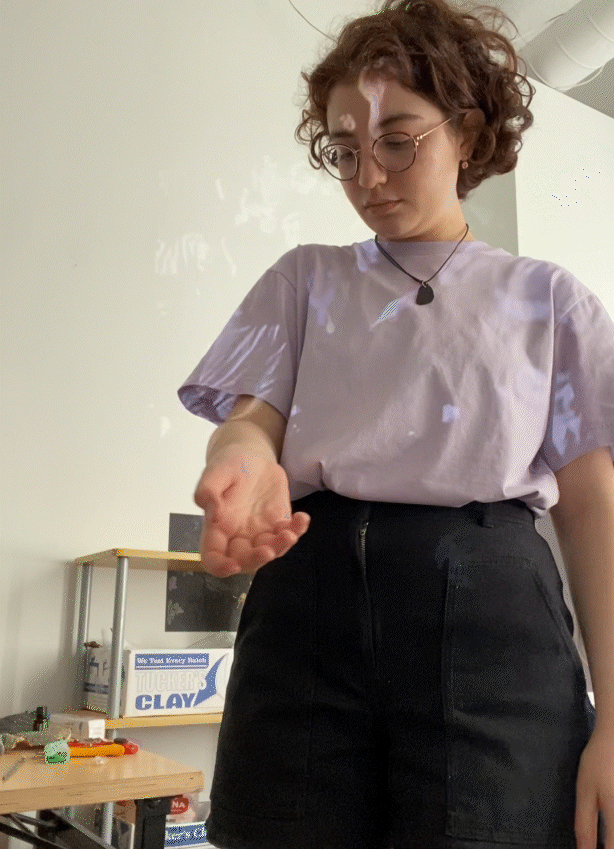
I also experimented with the possibility of projecting onto bodies, considering the viewer as an added dynamic material that could momentarily participate in the installation as they are the observer.
Azerbaijani Soviet film history is usually categorized in these segments,[7] based on the different authority present during these decades.
1920s – 1930s : Films were in accordance with the modernization and nativization period led by Stalin. This period established the Soviet Enlightenment, with motifs on modernization, revolution, secularism, women’s freedom, war on traditional structures and religion, and criticism of backwardness. Majority of films produced during this time were not directed by Azerbaijani directors.
1930s - 1940s : Film related to the WWII, the endurance of humanity during challenging economical and political times. Motifs also included historical heroism, alluding to the “unity of Azerbaijan”.
1950s – 1960s : Films included positive hopes for modernization after the war, ethnic inclusion begins with Kruschev’s authority.
1960s – 1970s : This was relatively a politically calm period in Azerbaijan. However, the optimistic tone of films is abandoned. Topics include the opposition of “historical heritage against new construction” as well as “traditional” vs “modern” knowledge, career, academic pursuits and the peace of family and friendships.
1980s – The films were reflective of the dissoluisnment that came with the fall of Soviet Union, and the results of increased political turmoil. The directors were much younger, and because of their direct experience growing up in Soviet Azerbaijan, their perspectives were more honest. The decades of the production of Soviet Azerbaijani films are usually muddled into 3 segments, “Soviet” (or Stalin’s period of ethnic homogenization and Sovietization during the 1920s to early 1940s), “anti-Soviet” (or post-Stalin period from 60s to early 80s where the position of modernisation projects within traditional culture was in conflict in the narrative), and “post-Soviet” (80s onwards where the reality and ramifications of Soviet imposition was seeping into public conscious heavily).
[7] For the sake of this project report, I have oversimplified these descriptions of Soviet Azerbaijani film categorizations from my conversations with Toğrul Abbasov, Aygün Aslanlı and Rəhman Badalov.
1920s – 1930s : Films were in accordance with the modernization and nativization period led by Stalin. This period established the Soviet Enlightenment, with motifs on modernization, revolution, secularism, women’s freedom, war on traditional structures and religion, and criticism of backwardness. Majority of films produced during this time were not directed by Azerbaijani directors.
1930s - 1940s : Film related to the WWII, the endurance of humanity during challenging economical and political times. Motifs also included historical heroism, alluding to the “unity of Azerbaijan”.
1950s – 1960s : Films included positive hopes for modernization after the war, ethnic inclusion begins with Kruschev’s authority.
1960s – 1970s : This was relatively a politically calm period in Azerbaijan. However, the optimistic tone of films is abandoned. Topics include the opposition of “historical heritage against new construction” as well as “traditional” vs “modern” knowledge, career, academic pursuits and the peace of family and friendships.
1980s – The films were reflective of the dissoluisnment that came with the fall of Soviet Union, and the results of increased political turmoil. The directors were much younger, and because of their direct experience growing up in Soviet Azerbaijan, their perspectives were more honest. The decades of the production of Soviet Azerbaijani films are usually muddled into 3 segments, “Soviet” (or Stalin’s period of ethnic homogenization and Sovietization during the 1920s to early 1940s), “anti-Soviet” (or post-Stalin period from 60s to early 80s where the position of modernisation projects within traditional culture was in conflict in the narrative), and “post-Soviet” (80s onwards where the reality and ramifications of Soviet imposition was seeping into public conscious heavily).
[7] For the sake of this project report, I have oversimplified these descriptions of Soviet Azerbaijani film categorizations from my conversations with Toğrul Abbasov, Aygün Aslanlı and Rəhman Badalov.
For this project, I chose three films that reflected this discourse: The Cloth Peddler (Arşın Mal Alan, 1945, directed by Rza Tahmasib, Nikolay Lechenko), In A Southern City (Bir Cənub Şəhərində, 1969, Eldar Quliyev, Rustam Ibrahimbeyov) and To Steal A Groom (Bəyin Oğurlanması, 1985, Vaqif Mustafayev). I was curious of the interaction that would happen when these film were paired together.
The Cloth Peddler
Based on the play written by renowned composer Uzeyir Hajibeyov, the film is about a man who desires to see the woman who will potentially marry beforehand, as opposed to traditionally being ‘handed’ a wife. Due to gender restriction of the time, he plots to enter womens’ houses by pretending to be a cloth peddler. Through this endeavour, he finds a beautiful woman. They both fall in love with each other and eventually after some challenges, marry in a happy ending. This film was considered commercial for its entertaining, digestible form, and slap-stick humor. It is recognizable for traditional elements, traditional garments, traditional dances, traditional wedding practices, and the traditional model of a love story.
In A Southern CityThe story revolves around Murad, a young man who lives by old ethical norms still prevalent in the suburbs of his city. He had promised Tofig, his childhood friend, to ‘hand’ him his sister as a wife. However, Tofig falls in love with a different girl, not following through the promise. According to the code of honor, Murad must take revenge. This is one of the first films ever produced in the Soviet Union to challenge the sociopolitical establishment, and was very controversial to release.
The Cloth Peddler
Based on the play written by renowned composer Uzeyir Hajibeyov, the film is about a man who desires to see the woman who will potentially marry beforehand, as opposed to traditionally being ‘handed’ a wife. Due to gender restriction of the time, he plots to enter womens’ houses by pretending to be a cloth peddler. Through this endeavour, he finds a beautiful woman. They both fall in love with each other and eventually after some challenges, marry in a happy ending. This film was considered commercial for its entertaining, digestible form, and slap-stick humor. It is recognizable for traditional elements, traditional garments, traditional dances, traditional wedding practices, and the traditional model of a love story.
In A Southern CityThe story revolves around Murad, a young man who lives by old ethical norms still prevalent in the suburbs of his city. He had promised Tofig, his childhood friend, to ‘hand’ him his sister as a wife. However, Tofig falls in love with a different girl, not following through the promise. According to the code of honor, Murad must take revenge. This is one of the first films ever produced in the Soviet Union to challenge the sociopolitical establishment, and was very controversial to release.
To Steal A GroomThe story revolves around a film director, unable to shoot a film about an Azerbaijani love story that includes challenges of inclusing traditional Azerbaijani wedding customs. He eventually decides to shoot a real wedding event. However the stubborn father of the bride resists approval of the plan. The film is self-reflective in the role of film within Azerbaijani society, and the importance of representative forms within audiovisual narratives.
“If Not this, Then What?”
The title of the installation plays on the classic “If not this, then that one” (O olmasın, bu olsun), both a classic play written by Uzeyir Hajibeyov and a film adaptation made in 1956. The title resonates with my efforts of mixing, pairing, matching elements of cultural signifiers (whether consciously or subconscious) in its continuous search. I was fascinated by the interaction of “tradition” as expected (through The Cloth Peddler), paired with the inhibiting forces of xalq mentaliteti (In A Southern City) within the context of representation in film (To Steal A Groom).
The question on what Azerbaijan’s cultural identity is would not be answered, but only its dynamics would be continuously revealed or concealed through the installation’s process.
“If Not this, Then What?”
The title of the installation plays on the classic “If not this, then that one” (O olmasın, bu olsun), both a classic play written by Uzeyir Hajibeyov and a film adaptation made in 1956. The title resonates with my efforts of mixing, pairing, matching elements of cultural signifiers (whether consciously or subconscious) in its continuous search. I was fascinated by the interaction of “tradition” as expected (through The Cloth Peddler), paired with the inhibiting forces of xalq mentaliteti (In A Southern City) within the context of representation in film (To Steal A Groom).
The question on what Azerbaijan’s cultural identity is would not be answered, but only its dynamics would be continuously revealed or concealed through the installation’s process.

Stills from the separate two videos that would be projected onto the installation. The left projector includes scenes from In A Southern City, with different scenes of crowds, men, old women gazing into the scene. The right projector includes scenes from The Cloth Peddler, where the women are dancing and singing in unison with fabrics in their hands. Both projectors include scenes from To Steal A Groom, where the crowd of actors are waiting for instructions from the film director. This decision of segmenting was consciously made in efforts to see how they would be in eventual conversation together.
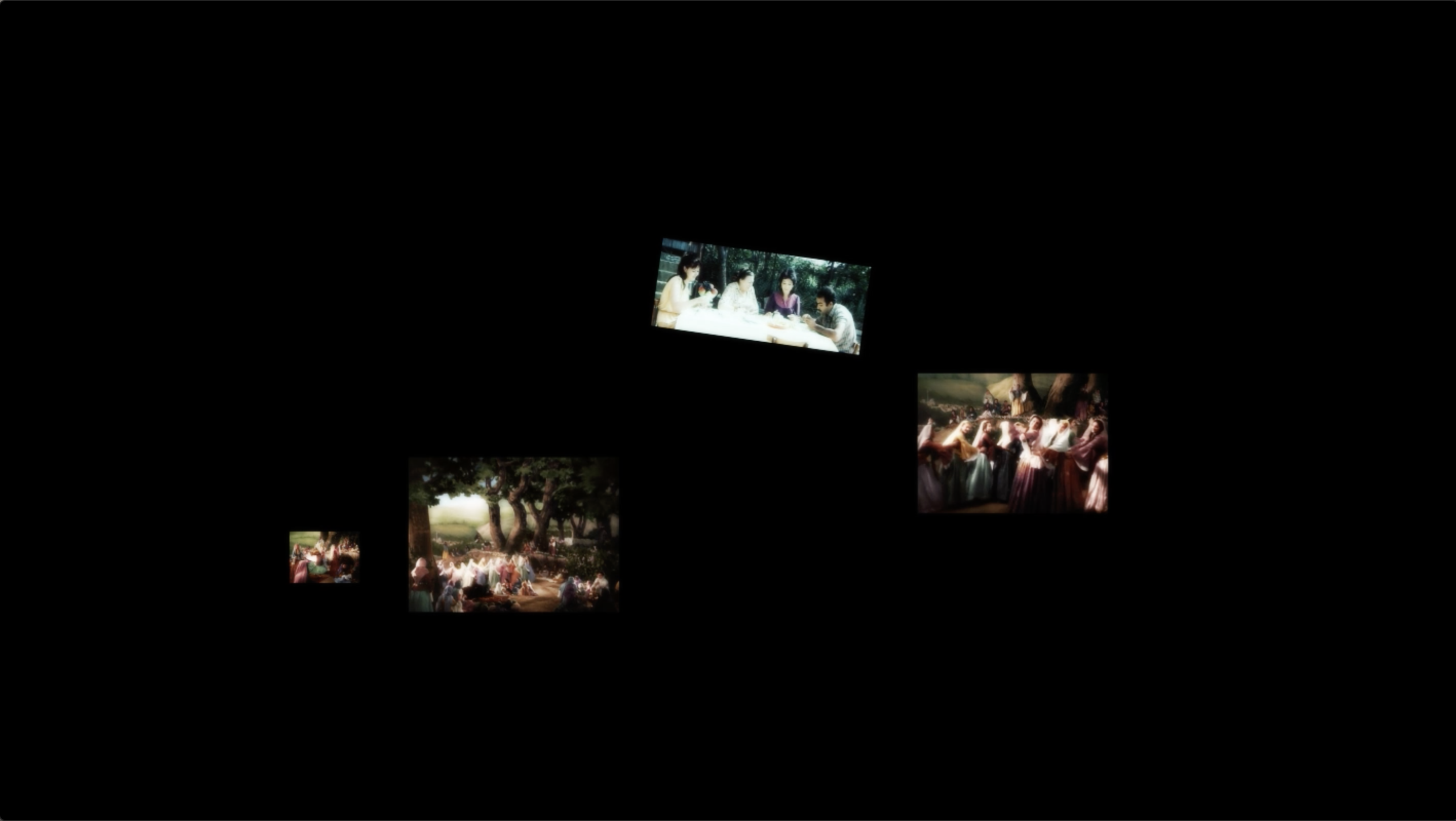
I was greatly inspired by contemporary multimedia artist Sarah Sze,
especially in her way to animate fractured
images with complexly balanced structures.
The found materials used in my installation were supported with clips and polyester rope. The setup was intended to be messy, chaotic, and happenstance. The objects would allude to the sense of architectural aggregation, the small corners or the abandoned spaces that can be found in the nooks of Baku. Most elements were still dependent on balance, so the installation still required for the observer to tread carefully around the setup. I hope to create a similar effect when I scale even bigger for my thesis project, as I appreciated the attention and care it required from the viewer. Additionaly, I enjoyed the freedom small portable objects provided. They allowed me to continue playing with the setup until I was satisfied with the visual composition.



Details from the setup of “If Not This, Then What?”
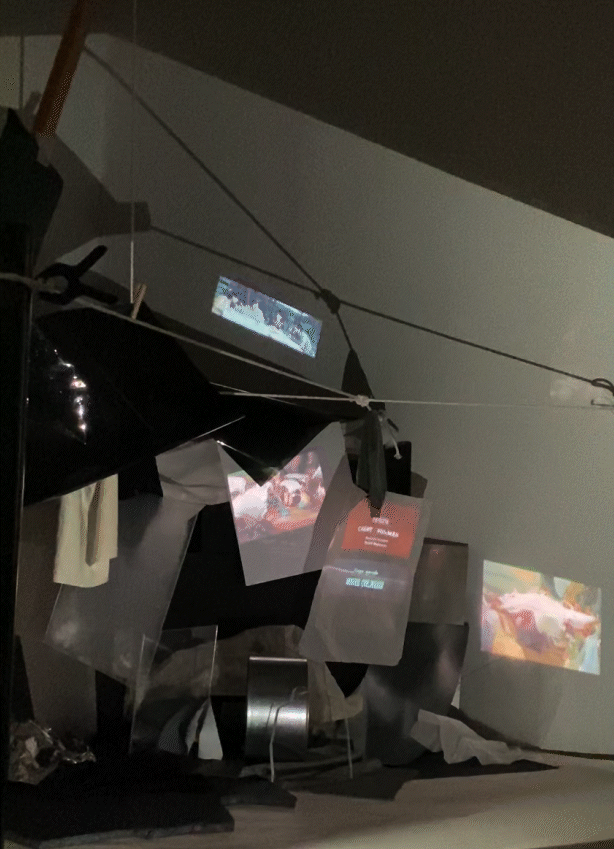
The installation is modelled through the process of research-creation. This implies that the process of the installation was not to calculate a final outcome, but to have moments of deliberate planning and organic construction happen simultaneously. As with the phsyical materials, the digital fragments of films were paired consciously enough to create a dialogue, but not delibarete enough to know what that dialogue would reveal. As the digital elements were placed on the materials, different materials started reflecting the images in fascinating ways. By the final installation, I was not completely sure which materials were reflecting the particular images on the wall, yet I embraced the findings as they occured.
Details from wall, “If not this, then what?”
 Details from still, “If not this, then what?”.
Details from still, “If not this, then what?”. Still image from “If not this, then what?”.
Still image from “If not this, then what?”.Reflection
The search to understand the dynamics of Azerbaijan’s cultural identity is ever-continuous, with each inquiry leading for new understandings to emerge. The current prototype of the installation was incredibly helpful to develop my material and theoretical research into a practical format of exploration. It also provided a valuable artistic logic that is replicable to my inquiry on Azerbaijani cultural identity. For the future iterations I hope to create more deliberate decision from my explorations, as re-enacting film scenes with actors, incorporating recorded or found sound materials, finding alternative ways to modify the found materials, while also learning how to create a cleaner installation set-up. Furthermore, I hope to scale even bigger with the next iteration, hoping to invite the viewer into the scene, as opposed to the current iteration where the installation is set as a theatrical display. I may further try using alternative Soviet Azerbaijani films, experimenting how the underlying sociopolitical narrative can interact in an intentional approach. I would like to further engage with a feminist perspective and haptic understanding of materiality for cultural theory, moving away from any possible nationalist implications of cultural inquiry.
![]()
New project questions:
What would an alternative to the nationalist (alternatively colonial, or driven by masculine narrative) implication of searching/utilising cultural identity be?
What drives the decisions to choose certain scenes of the films as opposed to the other to use as dialogue?
The search to understand the dynamics of Azerbaijan’s cultural identity is ever-continuous, with each inquiry leading for new understandings to emerge. The current prototype of the installation was incredibly helpful to develop my material and theoretical research into a practical format of exploration. It also provided a valuable artistic logic that is replicable to my inquiry on Azerbaijani cultural identity. For the future iterations I hope to create more deliberate decision from my explorations, as re-enacting film scenes with actors, incorporating recorded or found sound materials, finding alternative ways to modify the found materials, while also learning how to create a cleaner installation set-up. Furthermore, I hope to scale even bigger with the next iteration, hoping to invite the viewer into the scene, as opposed to the current iteration where the installation is set as a theatrical display. I may further try using alternative Soviet Azerbaijani films, experimenting how the underlying sociopolitical narrative can interact in an intentional approach. I would like to further engage with a feminist perspective and haptic understanding of materiality for cultural theory, moving away from any possible nationalist implications of cultural inquiry.

New project questions:
What would an alternative to the nationalist (alternatively colonial, or driven by masculine narrative) implication of searching/utilising cultural identity be?
What drives the decisions to choose certain scenes of the films as opposed to the other to use as dialogue?
Bibliography
Abbasov, Toğrul. “‘Some Angels Have a Moustache.’” Feminist Peace Collective, December 17, 2021. https://en.feministpeacecollective.com/post/some-angels-have-a-moustache.
Abbasov, Toğrul. “Soviet Azerbaijani Cinema and the Roots of Azerbaijani National Identity” in the author’s possession, 2022.
Ahmed, Sara. “The Orient and Other Others.” In Queer Phenomenology: Orientations, Objects, Others, 109-156. Durham, NC: Duke University Press, 2006.
Anderson, Benedict. Imagined Communities: Reflections on the Origin and Spread of Nationalism. London: Verso, 2006.
Badalov, Rahman. “Azerbaijan in a Changing Context.” In Gazet Art: No 1. Strasbourg: Springering Press, 2002.
Banine. Caucasian Days. London: Pushkin Press, 2019.
Boym, Svetlana, The Future of Nostalgia. NY: Basic Books, 2001.
Braudrillard, Jean. Simulation and Simulacra. University of Michigan Press, 1994.
Bruno, Giuliano. Surface: Matters of Aesthetics, Materiality, and Media. University Chicago Press, 2014.
Bruno, Giuliana. Atlas of Emotion: Journeys in Art, Architecture, and Film. London and Brooklyn: Verso, 2018.
Butler, Judith. Gender Trouble: Feminism and the Subversion of Identity. NY and London: Routledge, 2007.
Heyat, Farideh. Azeri Women in Transition: Women in Soviet and Post-Soviet Azerbaijan. Routledge, 2002.
Gasimova, Turkay. “Seeing the invisible: the representation of women both in fiction and reality”, Baku Research Institute, 1 November 2019. https://bakuresearchinstitute.org/en/seeing-the-invisible-the-representation-of-women-both-in-fiction-and-reality/
Ingold, Tim. “The Textility of Making.” Cambridge Journal of Economics 34 (2010), 91-102.
Kazımzade, Aydın. Kino və Zaman. Baku: Şərq Qərb Press, 2016.
Marks, Laura. The Skin of the Film. Durham and London: Duke University Press, 2000.
Manovich, Lev. The Language of New Media. MIT Press, 2001.
Mondloch, Kate. Screens: Viewing Media Installation Art. University of Minnesota Press: Minneapolis, Minnesota, 2010.
Noe, Alva. “Experience and Experiment in Art.” Journal of Consciousness Studies 7, 8–9, 2000, 123-35.
Rees, A.L., et al. Expanded Cinema: Art, Performance, Film. Tate Publishing: Millbank, London, 2011.
Rosen, Philip. Narrative, Apparatus, Ideology: A Film Theory Reader. New York: Columbia University Press, 1986.
Tohidi, Nayereh. “The intersection of gender, ethnicity and Islam in Soviet and post‐Soviet Azerbaijan” in Nationalities Papers: The Journal of Nationalism and Ethnicity, University of California, LA 2007.
Tlostanova, Madina, “Postsocialist ≠ postcolonial? On post-Soviet imaginary and global coloniality.” Journal of Postcolonial Writing 48, No. 2 (2012): 130-142.
Tlostanova, Madina. “What Does It Mean to Be Post-Soviet?: Decolonial Art from the Ruins of the Soviet Empire.” Duke University Press, 2018.
Said, Edward W. Orientalism. Vintage Books: New York and Toronto, 1979.
Shaffer, Brenda. Borders and Brethren: Iran and the Challenge of Azerbaijani Identity. London and Cambridge, MA: MIT Press, 2002.
Sultanova, Sevda, “A Brief History of Post-Soviet Era Cinema in Azerbaijan”, Baku Research Institute, 2019. https://bakuresearchinstitute.org/en/a-brief-history-of-post-soviet-era-cinema-in-azerbaijan/